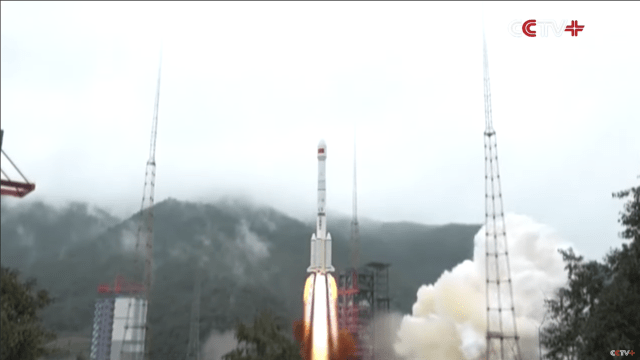China’s Shijian-21 spacecraft, a satellite with the stated purpose of cleaning up space junk, has an orbital companion, but we’re not entirely sure what it is.
The Shijian-21 satellite was launched to space by a Long March-3B rocket on October 23. Chinese state-run Xinhua news agency said the spacecraft “entered the planned orbit successfully” and that it “will be mainly used to test and verify space debris mitigation technologies.”
That’s pretty much all we know about Shijian-21, as China tends to be tight-lipped when it comes to its affairs in space. But on November 3, the U.S. military detected a companion object in orbit alongside Shijian-21, as SpaceNews reports. Space Force’s 18th Space Control Squadron catalogued it as an “apogee kick motor” and assigned it the designation 2021-094C.
Apogee kick motors are used to put payloads into their target orbits, a good example being satellites moved from their transfer orbits to geostationary orbits, also known as GEO. Satellites will sometimes eject their apogee kick motors after use, but as astrophysicist Jonathan McDowell from the Harvard-Smithsonian Centre for Astrophysics explained in an email, this is “pretty rare” and “almost always done by launching to the GEO graveyard, ejecting the motor, and then lowering the payload into GEO proper.”
Graveyard orbits, or junk orbits, are where satellites are placed once they’ve been retired. It’s done to minimise in-space collisions and the volume of dangerous space debris floating around up there. GEO, in case you’re wondering, is that special orbit in which satellites appear to hang motionless above a fixed point on Earth (an ideal configuration for telecommunications and weather satellites). But to eject an object within GEO itself “is a bad idea and very rare,” McDowell said, given the added risk of a collision in this functional orbital band.
But this line of speculation assumes the companion object is actually an apogee kick motor. It’s “currently unknown whether the object is an [apogee kick motor], an object possibly related to space debris mitigation tests, or part of potential counterspace operations tests,” according to Space News. “The object could be used to test rendezvous and proximity operations, refuelling experiments or manipulation using a robotic arm or other means.”
McDowell is likewise uncertain about the companion object being an apogee kick motor. Currently, both Shijian-21 and 2021-094C are in orbit some 80 km above pure GEO, “which is well within the band” used by relocating GEO satellites, he said. The two objects are 60 km apart, which “appears to be a deliberate synchronisation,” said McDowell, to which he added: “If you just ejected and said bye-bye, you’d expect a steadily increasing separation.”
McDowell suspects Shijian-21 and 2021-094C are active payloads working in tandem, possibly monitoring radio signals from other GEO satellites, but he said we’ll have to wait a few months and see if either object makes some kind of manoeuvre to be sure.
Importantly, China’s Tongxin Jishu Shiyan-3 satellite, or TJS-3, did something similar back in 2018, producing a companion object, or “sub-satellite.” The “pair manoeuvred in concert and carried operations including spoofing, which involves coordinated manoeuvres at certain times in an attempt to confuse rivals’ space tracking networks,” according to SpaceNews. As in the current situation, Space Force classified that companion object as an apogee kick motor.
“I don’t know why Space Force thinks these second objects are apogee kick motors — is it just an (incorrect) guess on their part or do they have classified sensor data that is leading them to this conclusion?” said McDowell. That said, he believes the two missions, Tongxin Jishu Shiyan-3 and Shijian-21, “are related in some way.”
Hopefully we’ll know more in a few weeks or months, but for now we’re forced to speculate.
